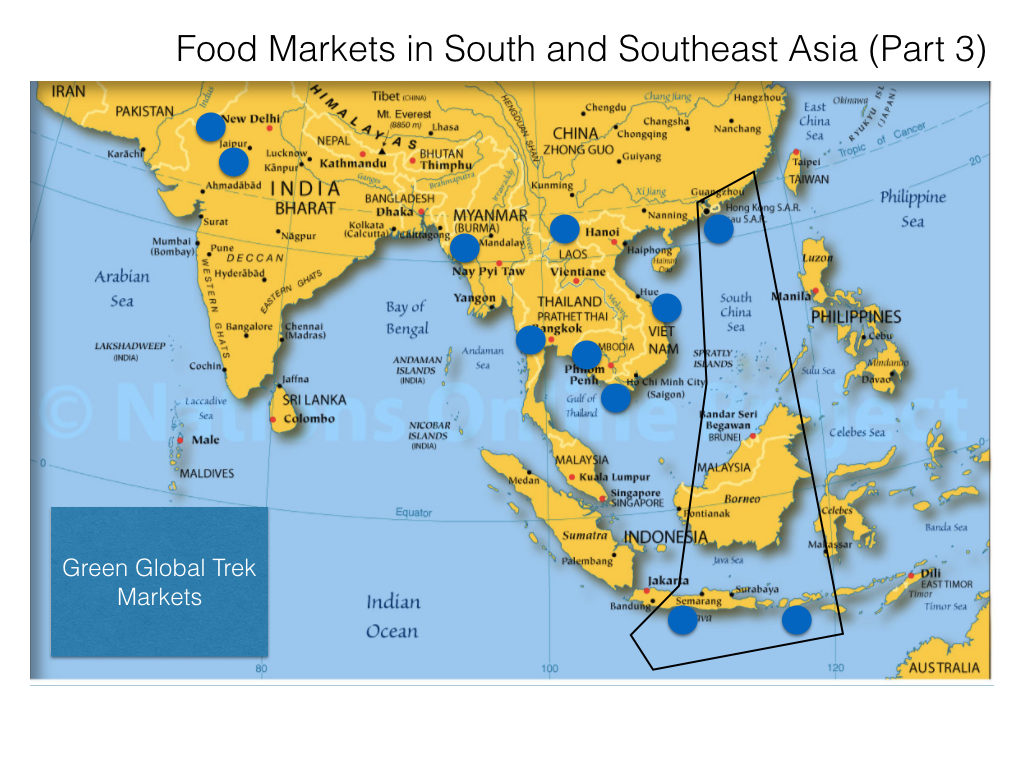 Our first retrospective post in this series on the markets of Asia, focused on markets in Viet Nam. The second post featured markets in Thailand, Myanmar and Cambodia.
Our first retrospective post in this series on the markets of Asia, focused on markets in Viet Nam. The second post featured markets in Thailand, Myanmar and Cambodia.
This third post takes us back to Indonesia and Hong Kong. Two completely different cultural environments, which are of course reflected in the markets we visited.
Market in Yogyakarta, Indonesia
Indonesia is the world’s largest Muslim nation. It has a dynamic economy and a relatively young population. As is true everywhere around the world, there is a centrifugal pull leading to migration of people from rural areas to the big cities. One such large city on the Island of Java, is Yogyakarta (aka Jogja).
While we were in Yogyakarta for Ben’s business (consulting with a UN agency re the potential for bamboo industry development in Indonesia, we of course went to the jogja food market.
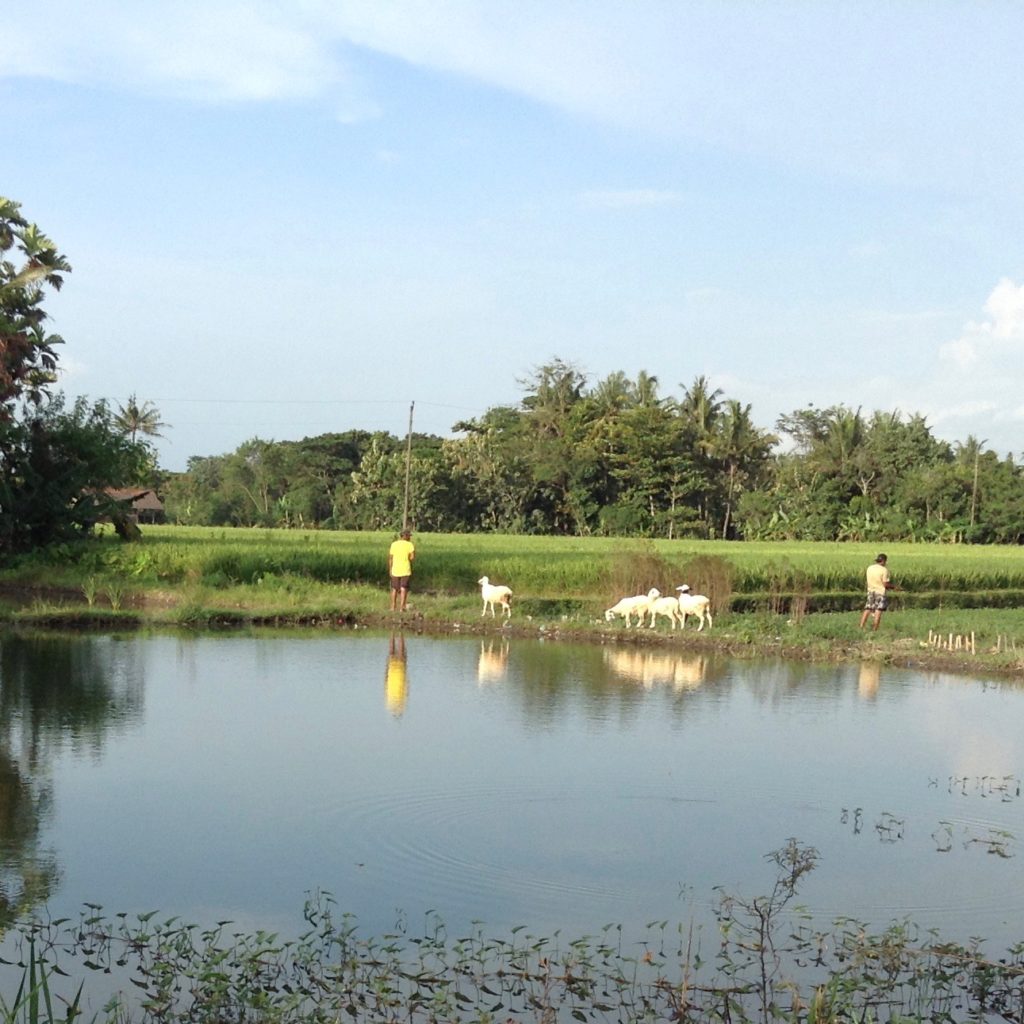
We were staying on the outskirts of the big city of Yogyakarta so that we could enjoy the serenity of rural life.
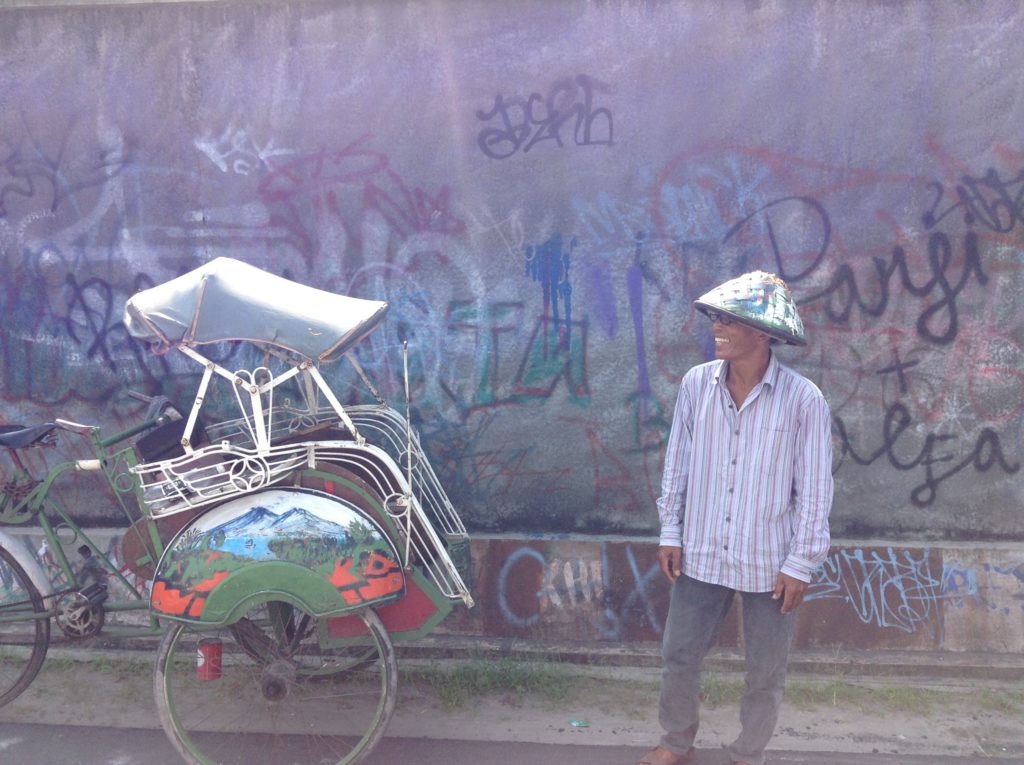
The first thing one notices upon arrival in Yogyakarta is the omnipresence of rickshaws, which are often painted with landscapes or colorful designs. Art on the move. And the backdrop is a never ending stream of often thought provoking graffitti/street art and murals.
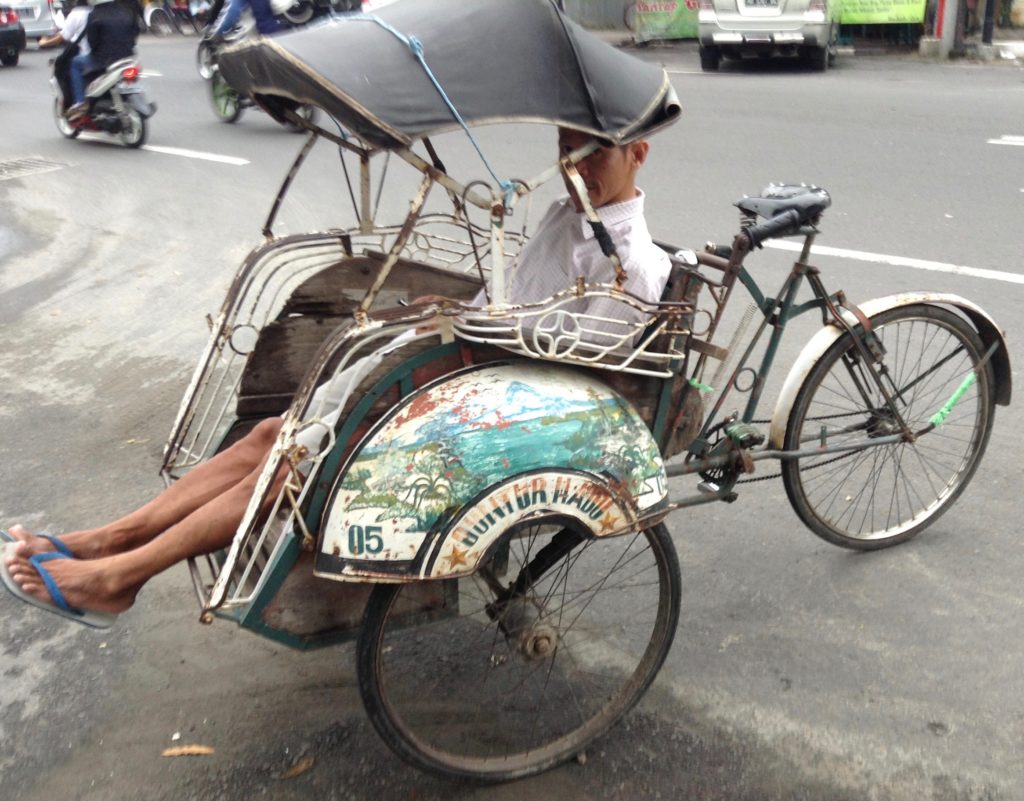
Artistry is everywhere in Indonesia. In the fabrics, the batik, the sculptures and the rickshaws are no exception. Each rickshaw itself a unique “canvas” for the driver’s personal expression.

We start with my favorite photo from the market in Jogja, this woman selling a variety of different shapes and colors of eggs, some of which are a light teal, a lighter shade of the wall behind her.
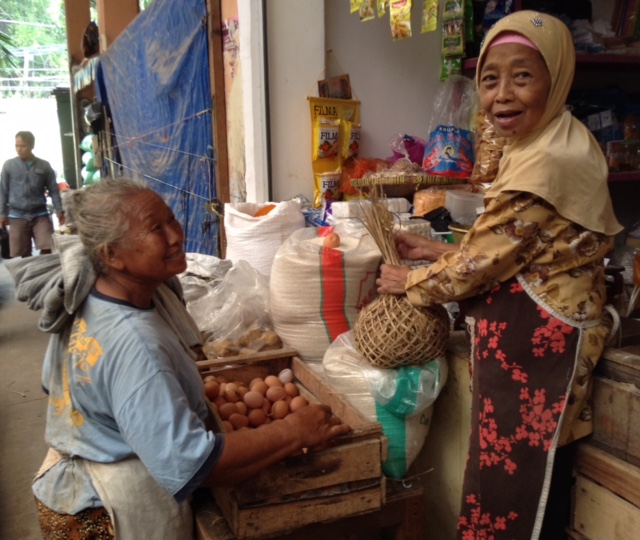
Another egg vendor, (and there were many), bags her eggs in a reed rope bag for her customers to carry away.
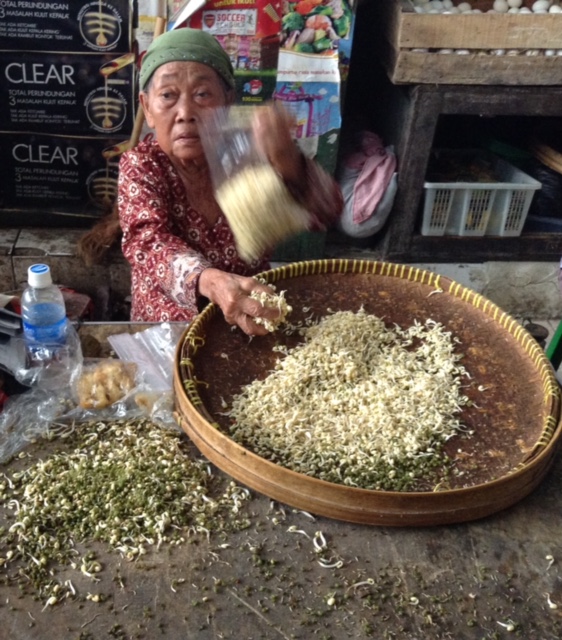
Bean sprouts in a bamboo basket being scooped to fill bags for eager customers. A life built around sprouts.

Favorite character of the market… cigar chomping lime and lemon vendor nestled amongst the baskets and bags of produce.

Ben getting an education on the local spices ~ the variety and what they are used for.

A wooden grid of spices in front of the scale and shelved products.
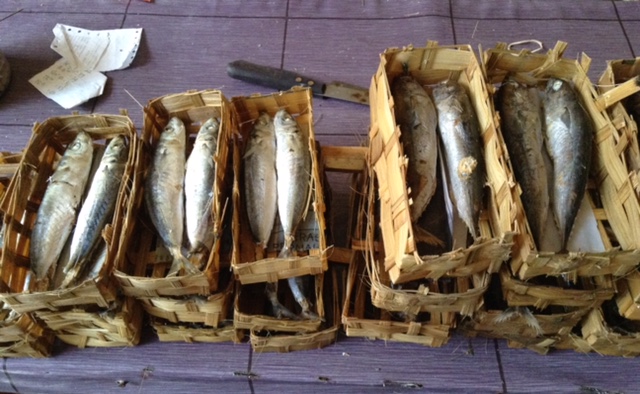 Two smoked silver and white fish per handmade rattan box, ready to go.
Two smoked silver and white fish per handmade rattan box, ready to go.
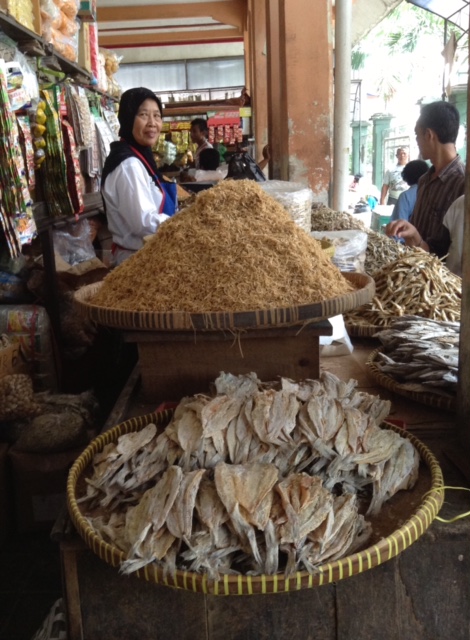
At this stall dried fish carcasses are laid out and tiny dried shrimp piled high into pyramids in bamboo trays.
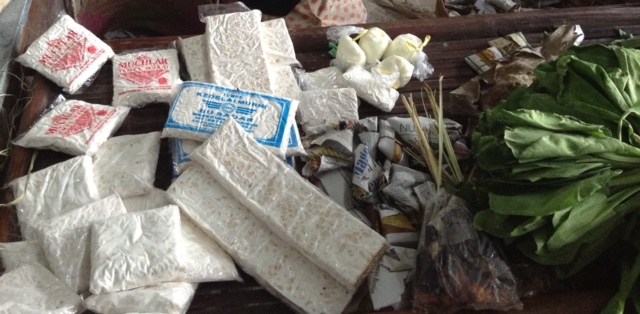

In one section of the market food is being prepared… beans and cabbage are shredded and then bagged to sell, making home cooking just a bit quicker and easier.
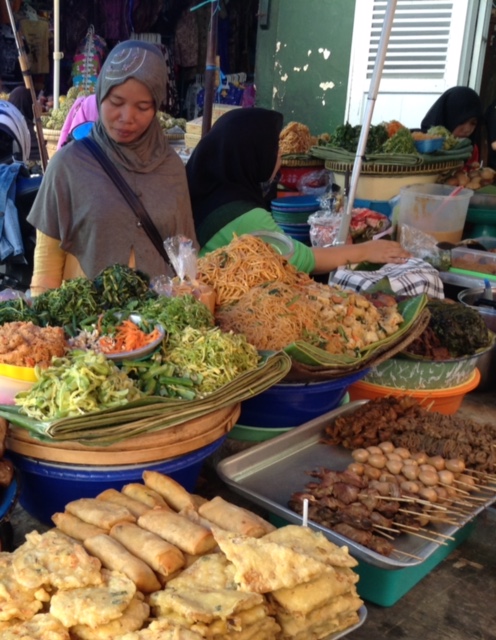
Prepared foods are often a feature in markets and give one an idea of how the produce is used and what local snacks are made of.

These half moon discs of “jaggery” are made from boiling palm syrup which solidifies into a hard sugar like substance and is a healthy substitute for sugar. Jaggery has a variety of nutritional benefits.
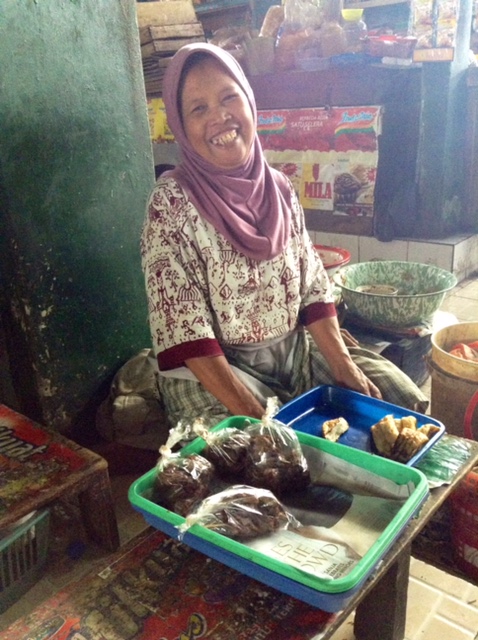
Not sure what this woman is selling, but she caught our attention with her huge smile and warmth.
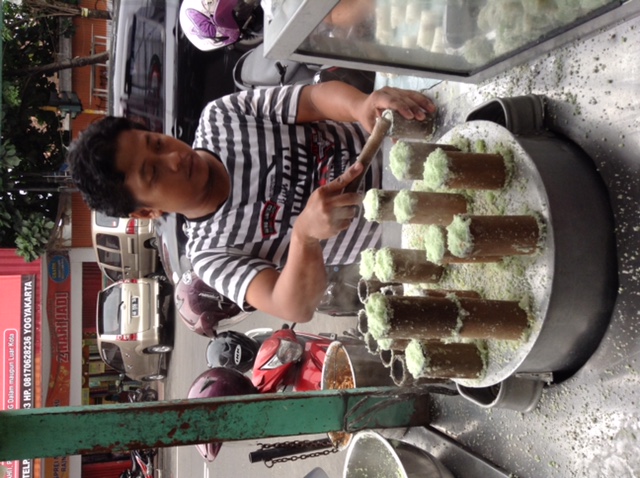 Coconut treats are just one of the many sweets on offer in the streets nearby the market. The grated coconut is compressed in bamboo cylinders and then steamed into a cylinder shaped sweet “hand roll”.
Coconut treats are just one of the many sweets on offer in the streets nearby the market. The grated coconut is compressed in bamboo cylinders and then steamed into a cylinder shaped sweet “hand roll”.
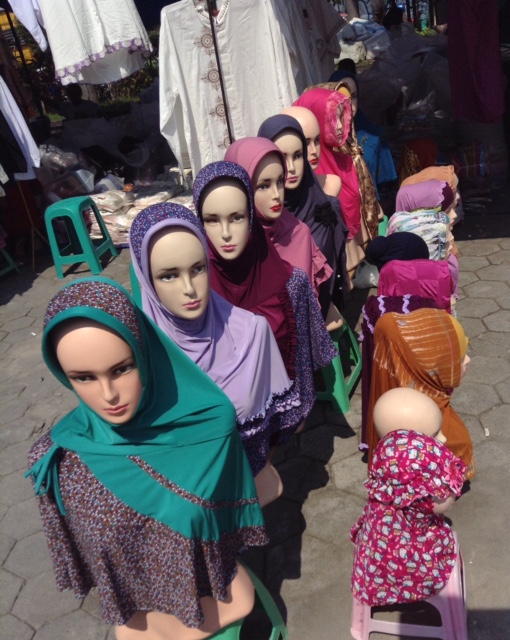
Just outside the food market is the fashion market where women have a large selection of fashionable hijabs to choose from.
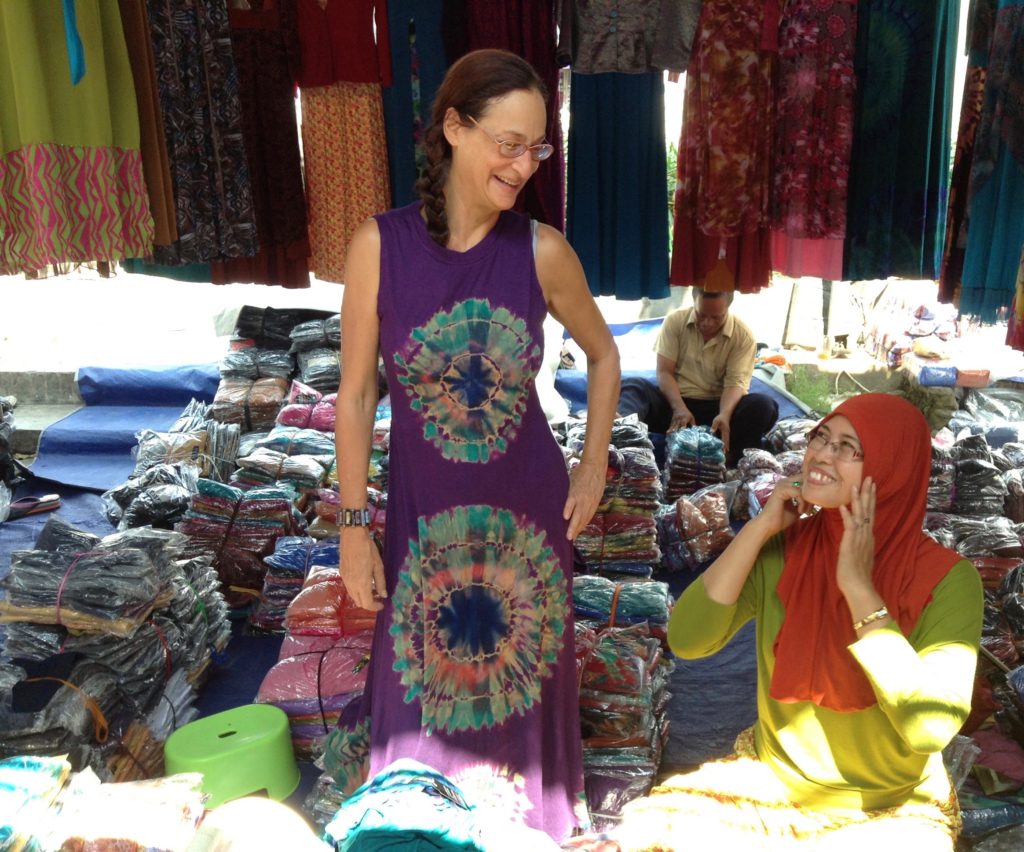
Girls will be girls… fashion provides an easy way for Peta to interact with this friendly Muslim woman selling clothes and hijabs. Peta bought a dress after much input from a group of local women who were all delightedly watching and giving their opinion on which dress looked best
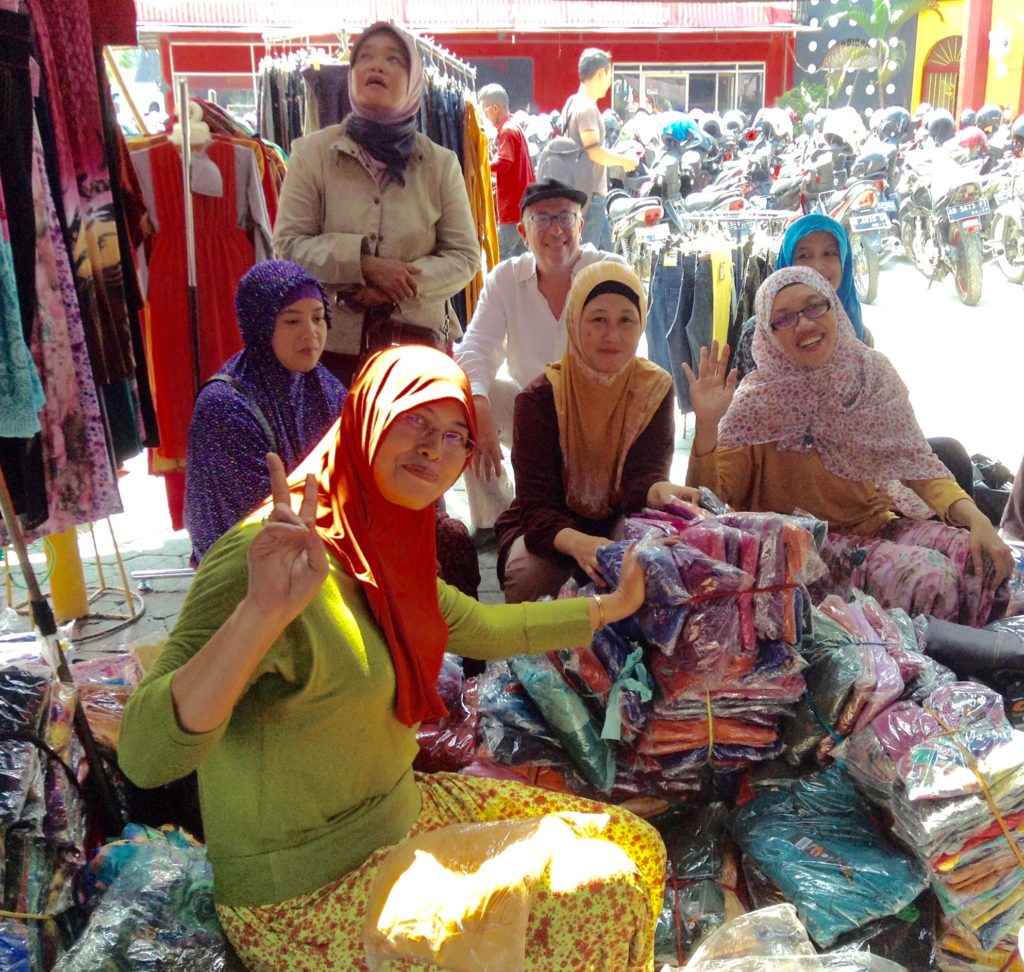
And here is the friendly group of opinionated women who contributed to the ultimate selection of a teal colored dress. And there is Ben, enjoying the fashion show too.
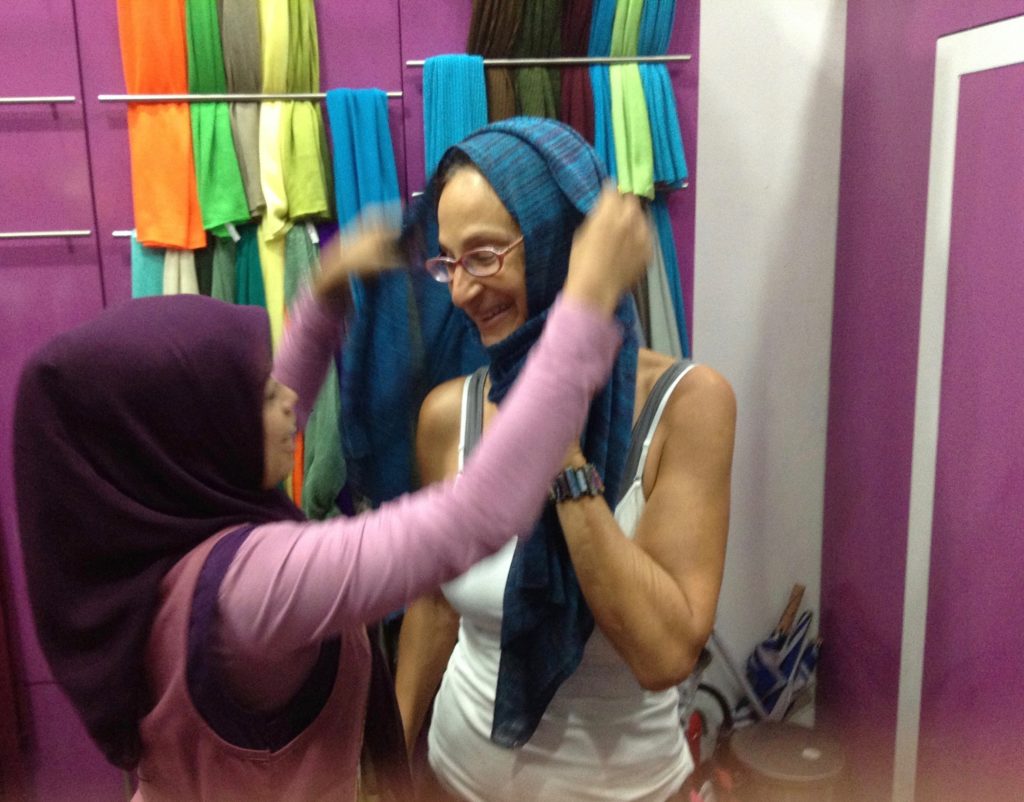
Of course Peta tried on a few hijabs! She was curious to see how they looked on her and how it felt to wear one. When in Rome…. (or in this case, Yogyakarta).
Market in Ubud, Bali, Indonesia
While Indonesia, a huge archipelago of many large, medium and small islands, is overwhelmingly Muslim, the island of Bali is, almost entirely Hindu. Bali’s unique ethnic and religious profile reaches back to pre-Muslim times when Javanese kings and their court, relocated to Ubud from Java.
Ever since then, Bali has had a rich and complex history of interaction with the rest of the Indonesian nation state. Even today, Bali defends its “minority” status as a Hindu enclave when national policy is made.
The architectural beauty of Ubud, is breathtaking. Rice cultivation is a main contributor to Bali’s economy, and the visuals of rice-fields are spectacular. But without a doubt, what for us, makes Bali so visually striking is the perpetual rhythm of ceremonies ~ in the streets, in homes, at the many temples, in small communities. And it all starts with the preparation in the market.
Over the past 3 years, we have returned several times to what feels like home to us, ubud, bali .
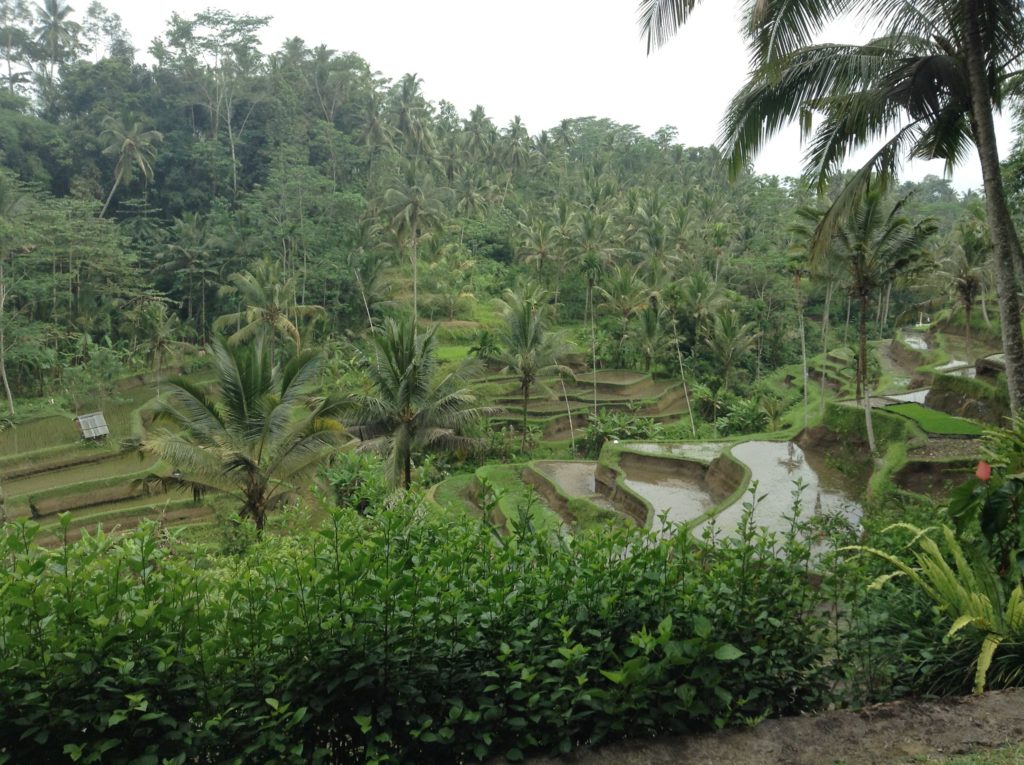
The ancient system of terraced rice paddies creates dramatic landscapes. This was our view from one of our home exchanges in Bali.
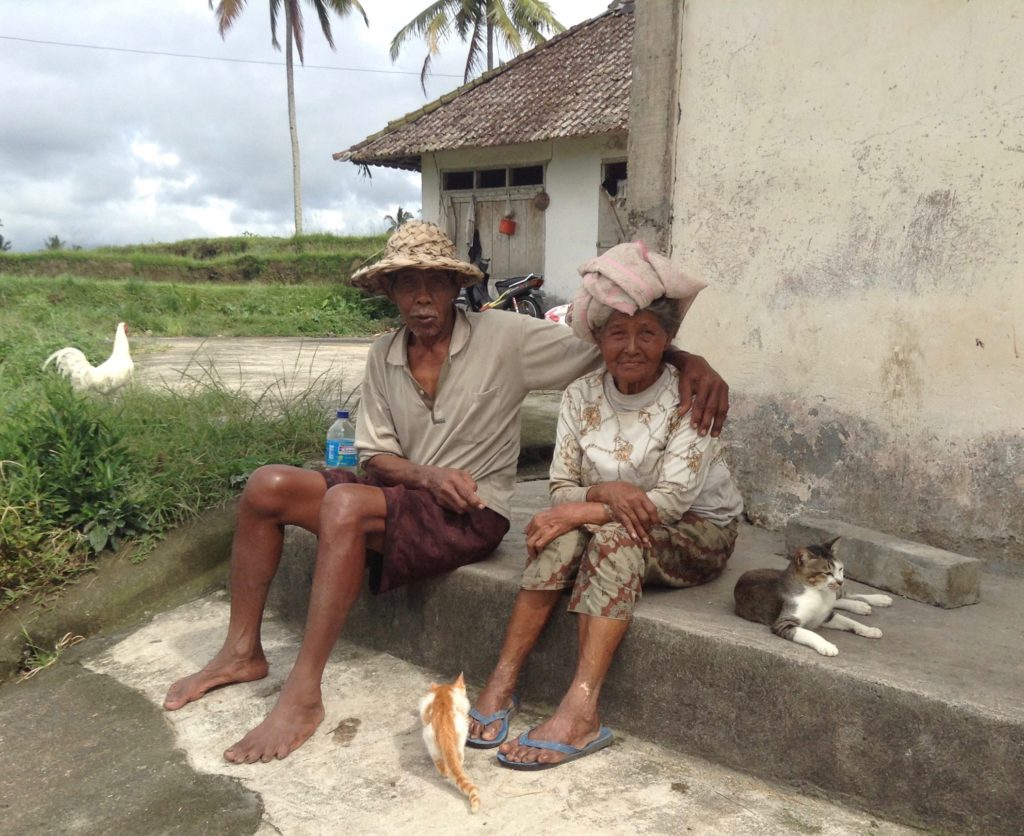
A touching elderly couple living in a rural area with their cats and chickens, whom we stop to chat with on the way to the market.

A birds eye view of the market in Ubud.

The most striking characteristic of the market in Ubud is the abundance and variety of bright flowers, all destined for daily ceremonies.

Flowers are grown specifically for the purpose of daily offerings to the spirits, and ceremonies. Here a shopper is taking time to carefully select a good bunch of flowers.
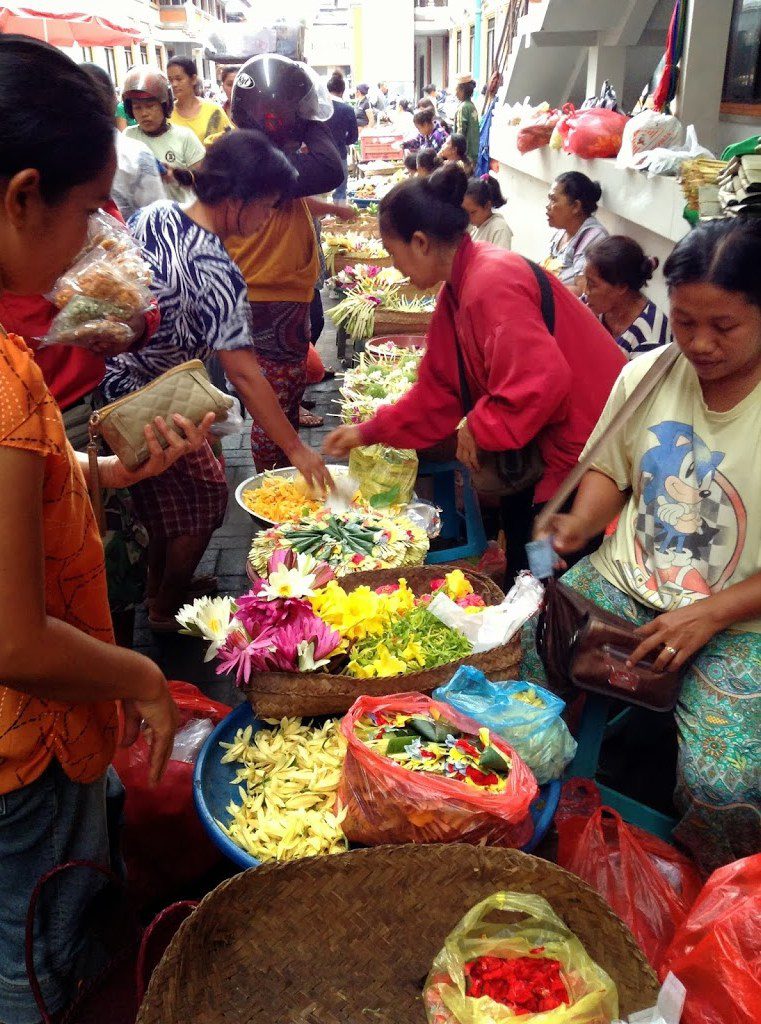
The fragrance of the flowers is heady stuff, and the flower vendors are constantly busy selling to customers.

Bamboo baskets of red and white petals which will join incense and sticky rice as part of a parcel of offerings.
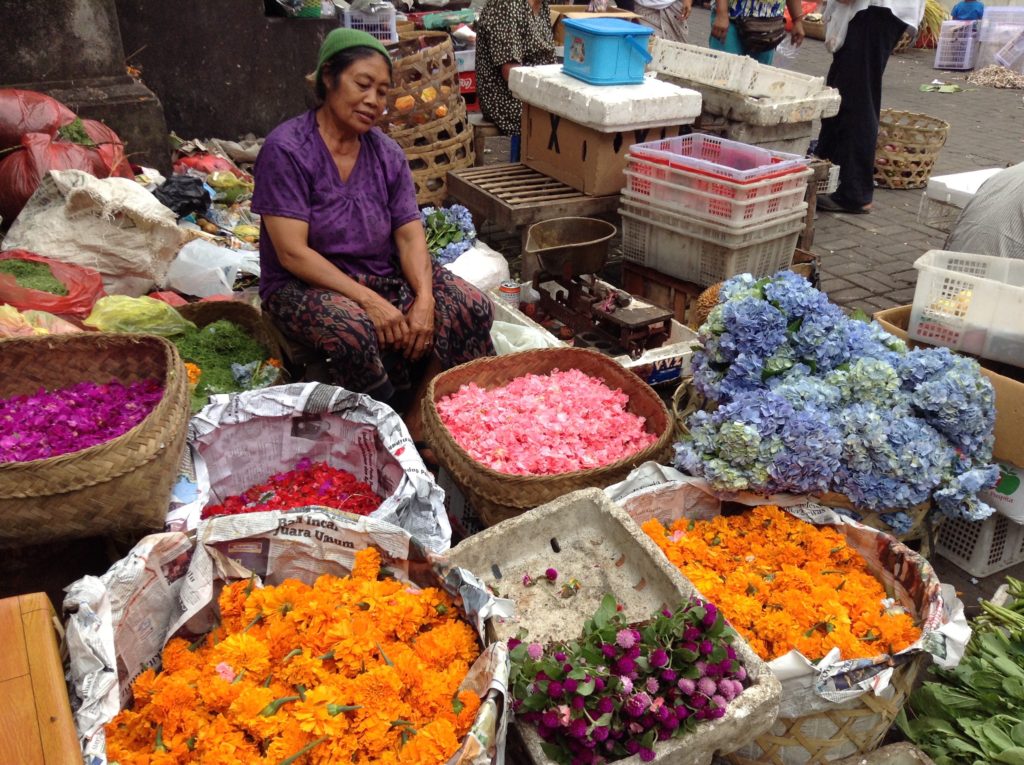
A rainbow of colors!

Peta strolling the market. So much to see and take in, that we move really slowly. There is no rush.
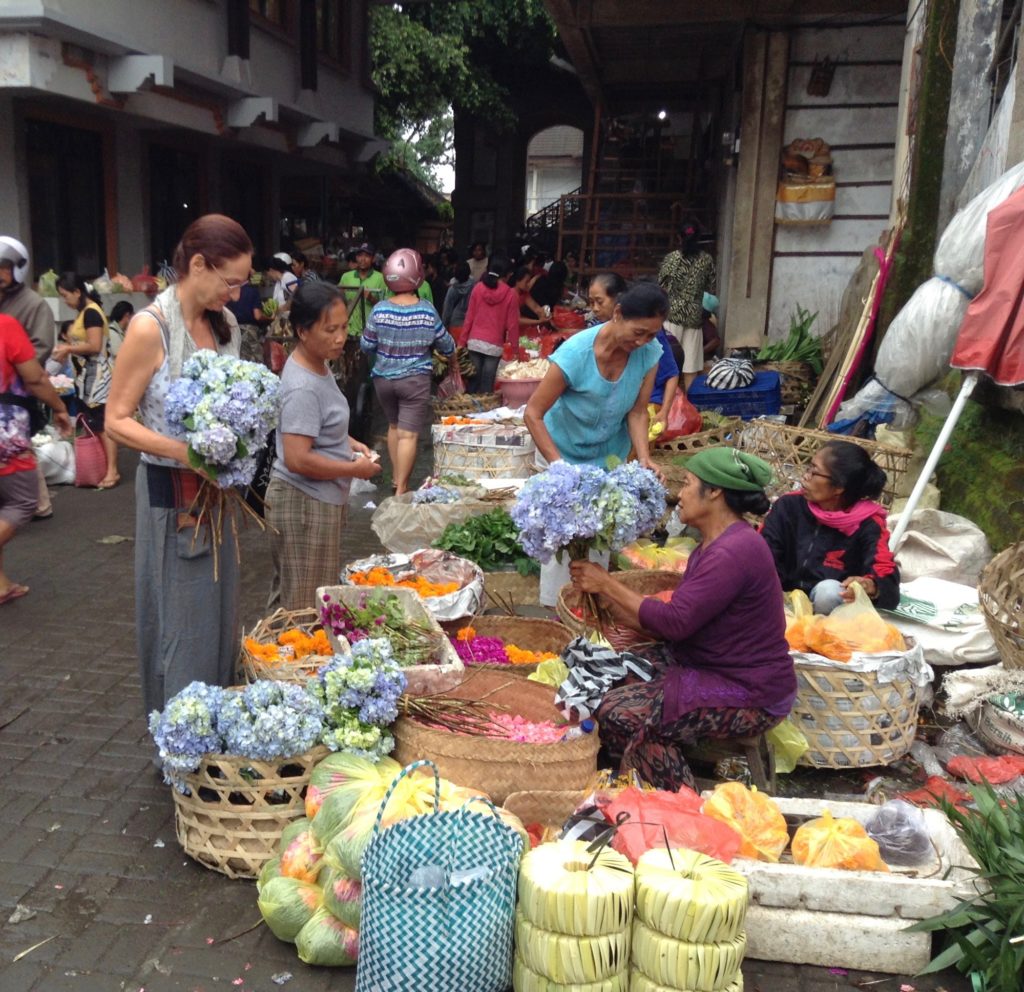
The blue hydrangeas are just too hard to resist. We buy a bunch to enjoy.
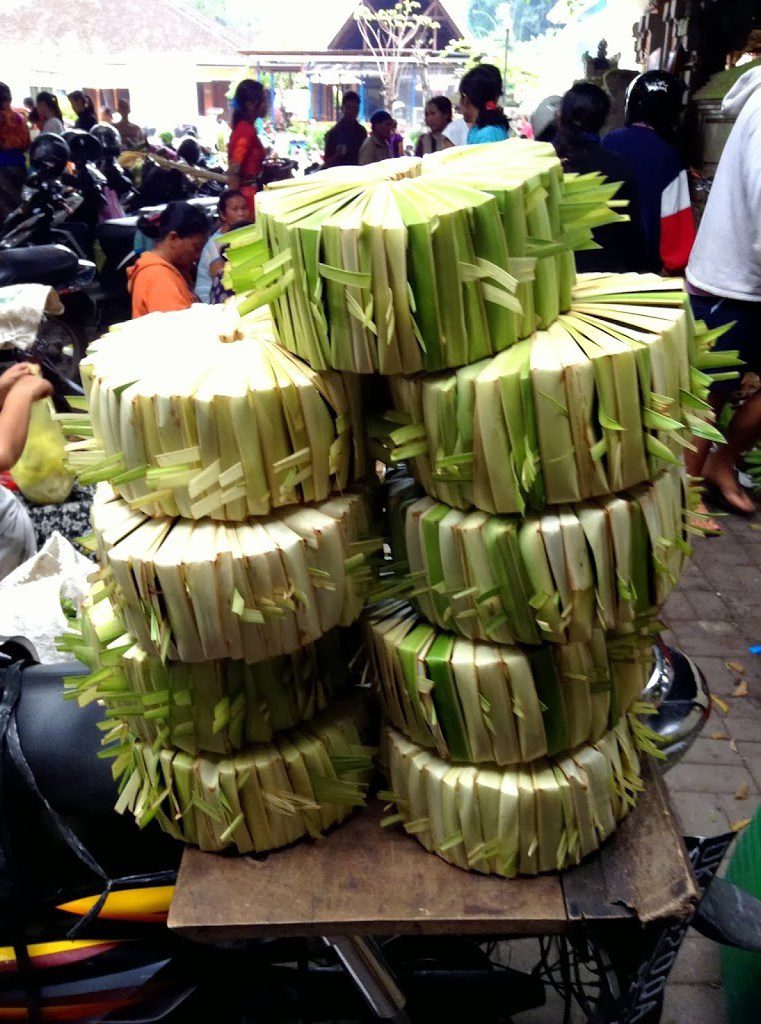
Bamboo leaves make up the little trays for offerings. Here they are all stacked together into a neat circle, and being delivered to the vendors at the market. Some people make their own but others buy them ready made at the market.
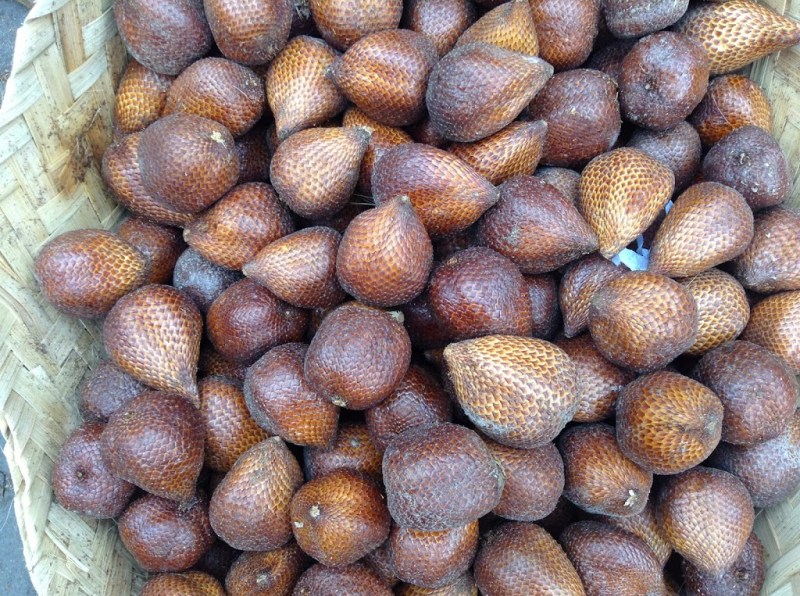
We love discovering new fruits, and snake skin (aptly named) was new for us. The peel is thin and hard and looks like the skin of a snake. The inside is comprised of 3 or 4 segments, each with a pit surrounded by crunchy white flesh which feels like a hard apple and tastes like a combination of a pineapple and a lemon. Yum!

Bright colors at the market are always a feast for the eyes.

Balancing ones purchases on ones head is definitely a well honed skill, not for the novice 🙂
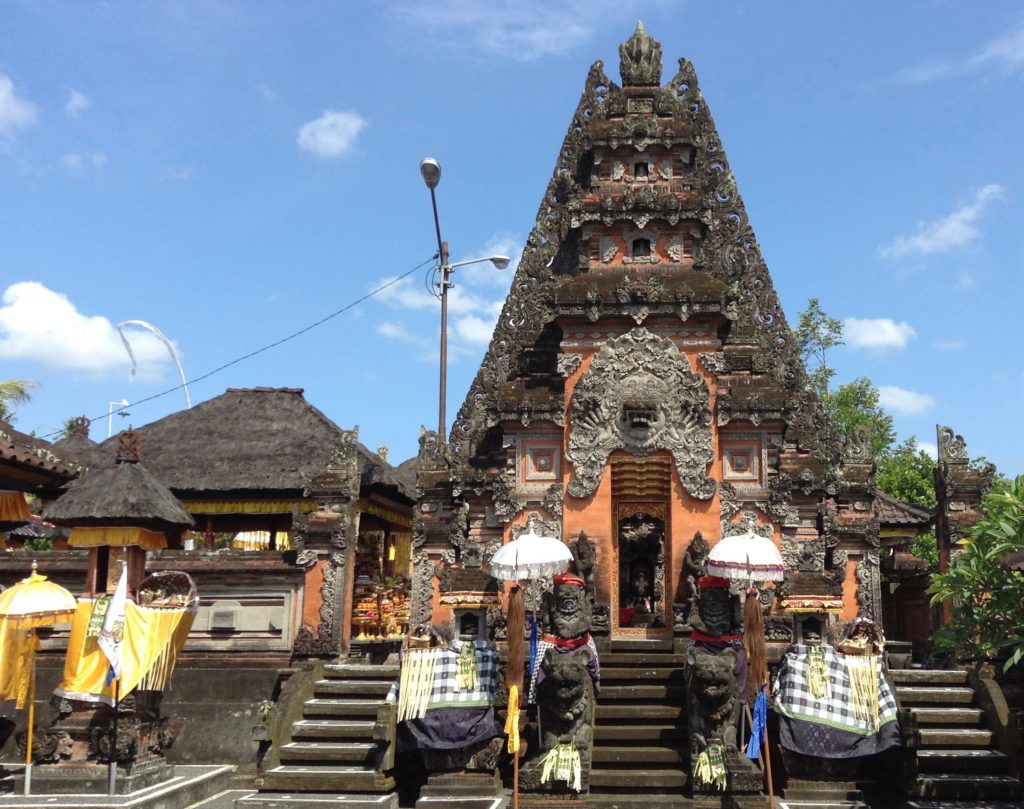 Elaborate temples are decorated and ready for ceremony. Inside there are pyramids of flowers and fruits from the market which serve as offerings to the spirits. The form of Hinduism practiced in Bali, is unique in that it draws from ancient Hindu traditions but also allows for the continued worship of animist beliefs that permeated the culture before Hinduism took hold as a dominant religion in Bali.
Elaborate temples are decorated and ready for ceremony. Inside there are pyramids of flowers and fruits from the market which serve as offerings to the spirits. The form of Hinduism practiced in Bali, is unique in that it draws from ancient Hindu traditions but also allows for the continued worship of animist beliefs that permeated the culture before Hinduism took hold as a dominant religion in Bali.

The use of bamboo and fabric in ceremonies is something to behold. They create a great sense of drama and occasion as they sweep into the blue sky.

We were honored to be invited to a rare 30 year temple ceremony in a rural village near where we were staying. A neighbor was the puppet master and thoughtfully invited us to join him. We had a rare behind the scenes experience of participating in a ceremony from behind the puppet masters narration table.
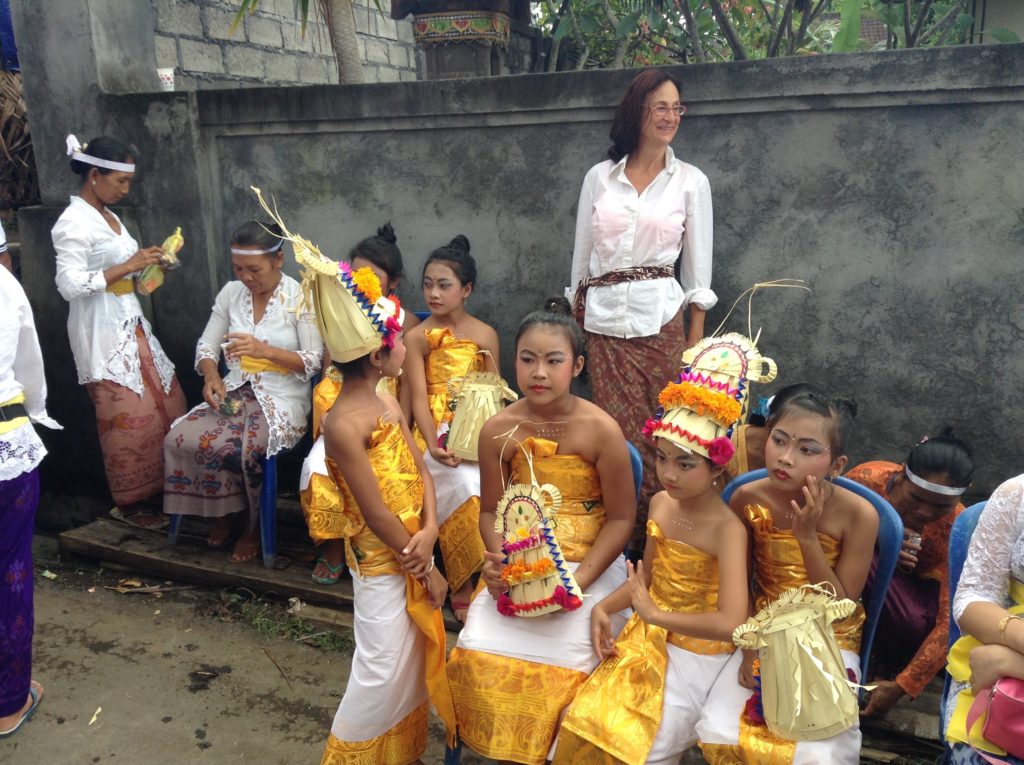
Waiting with the young dancer girls for their big moment during the ceremony.

A young Balinese dancer before her participation in the group dance, enjoying a light moment.
Market in Hong Kong
The flow of life in Bali has little in common with the hectic pace that characterizes life in the big city of Hong Kong.
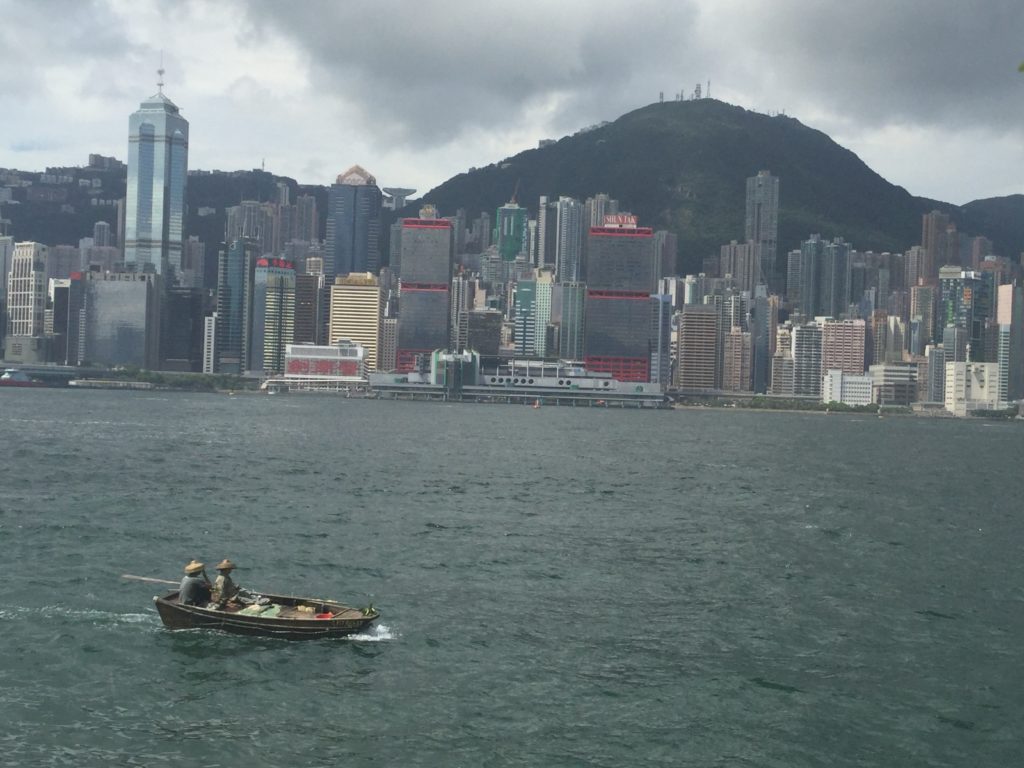
Hong Kong skyline. We are no longer in rural Asia!
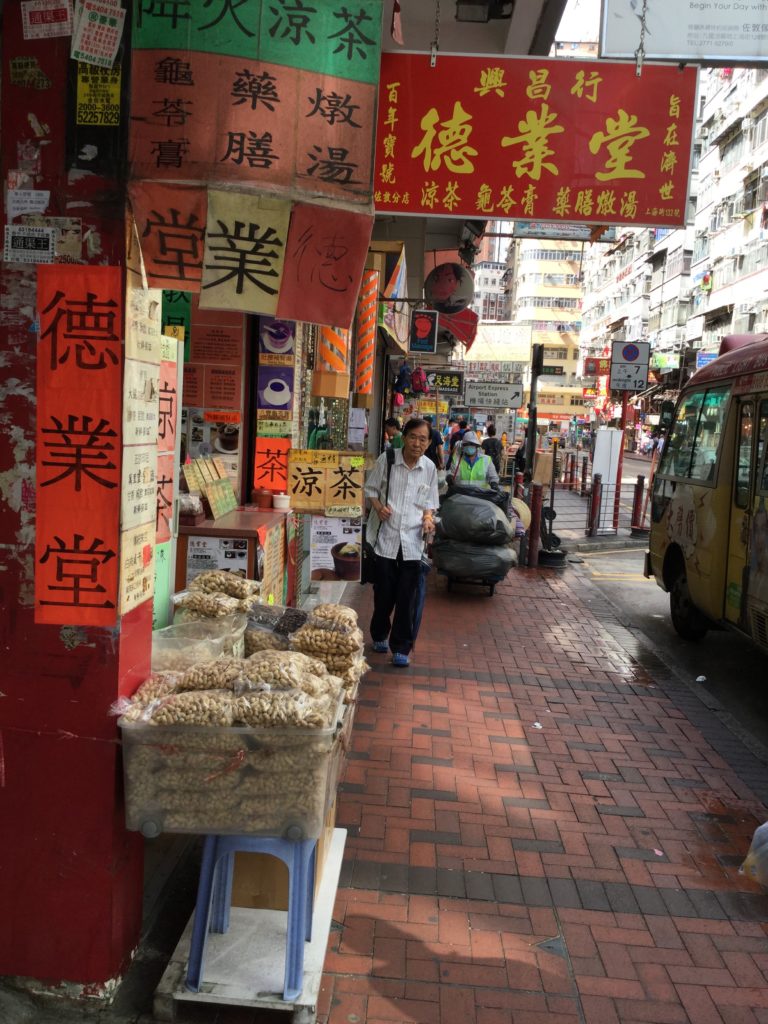
This area of Hong Kong is known as the medicine “market”. This is where locals go to purchase every type of Chinese herbal medicine, teas, dried fungi, dried fruits and many non recognizable (to us) items.

As all the signs are written in Cantonese we have no idea what most of these products are and what they are used for.
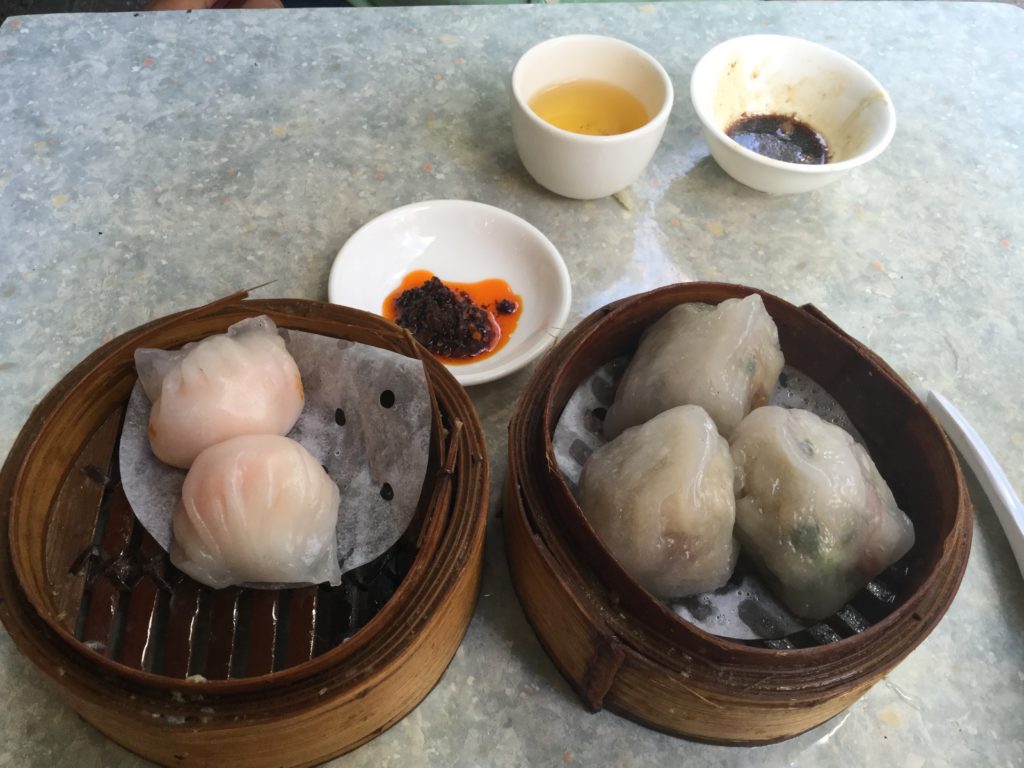
As we get closer to the market we have to stop of course for some dim sum ~ the quintessential Hong Kong cuisine, long a favorite in our family, and in of itself sufficient reason for us to visit Hong Kong!
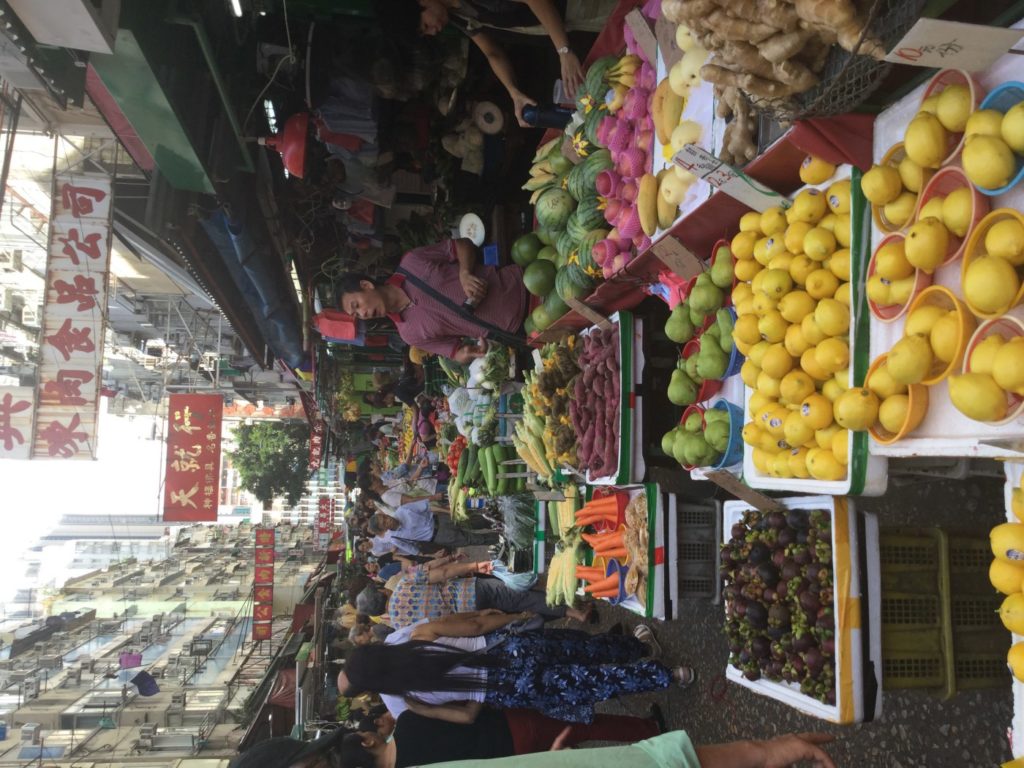
A ferry takes us to Kowloon across the bay, where we happily stumble on a large market with produce all organized very neatly.
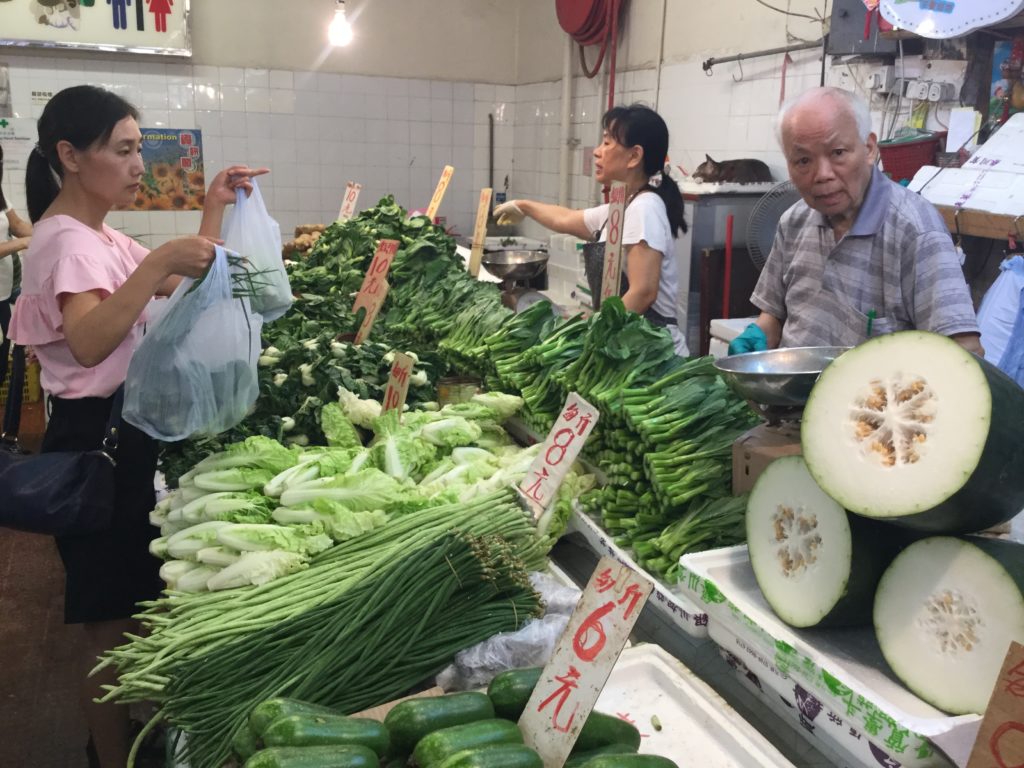
No shortage of good looking greens here, and some huge type of melon/cucumber looking thing on the right hand side.
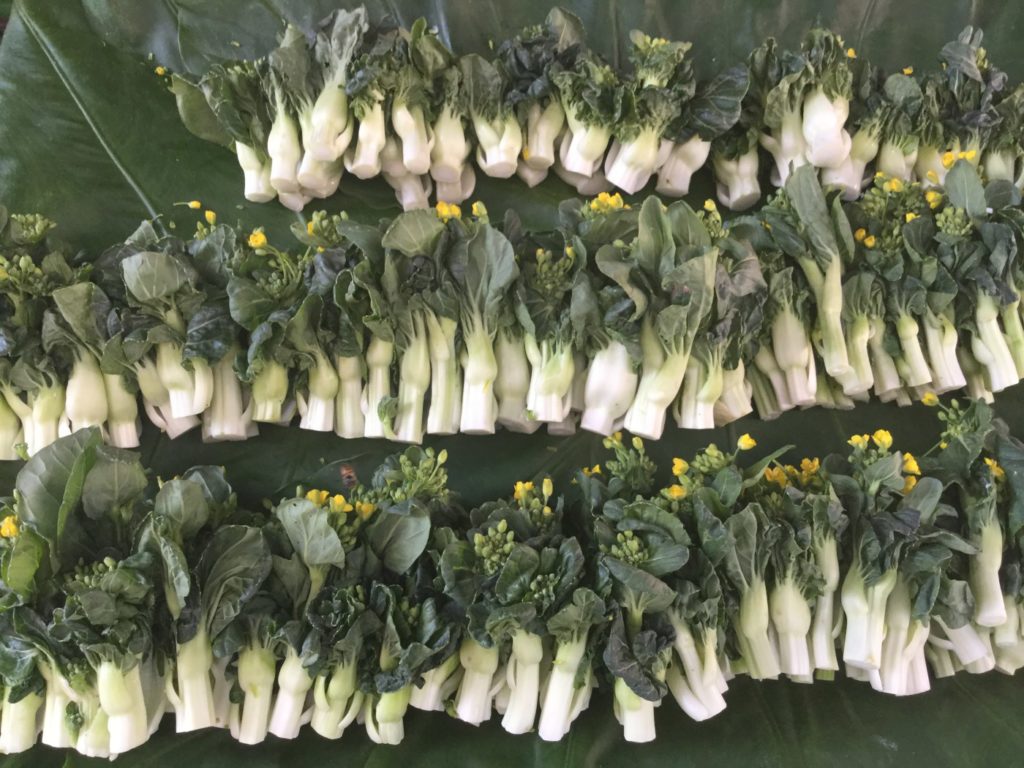
Beautiful looking flowering baby bok choy all lined up neatly in rows. We have never seen this variety of mini? bok choy before, which is part of the fun of markets… to see produce that is new to us.
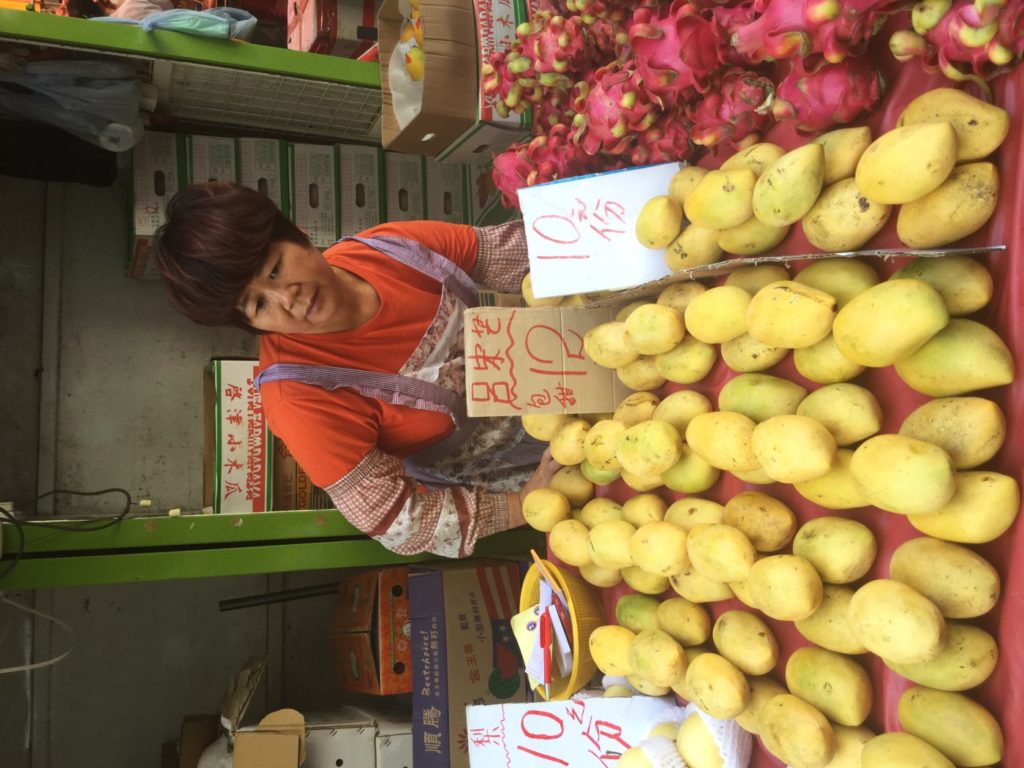
There is such a sense of order in this market. Neat rows of produce all line up. Everything clearly marked with prices. Here rows of fragrant mangoes.
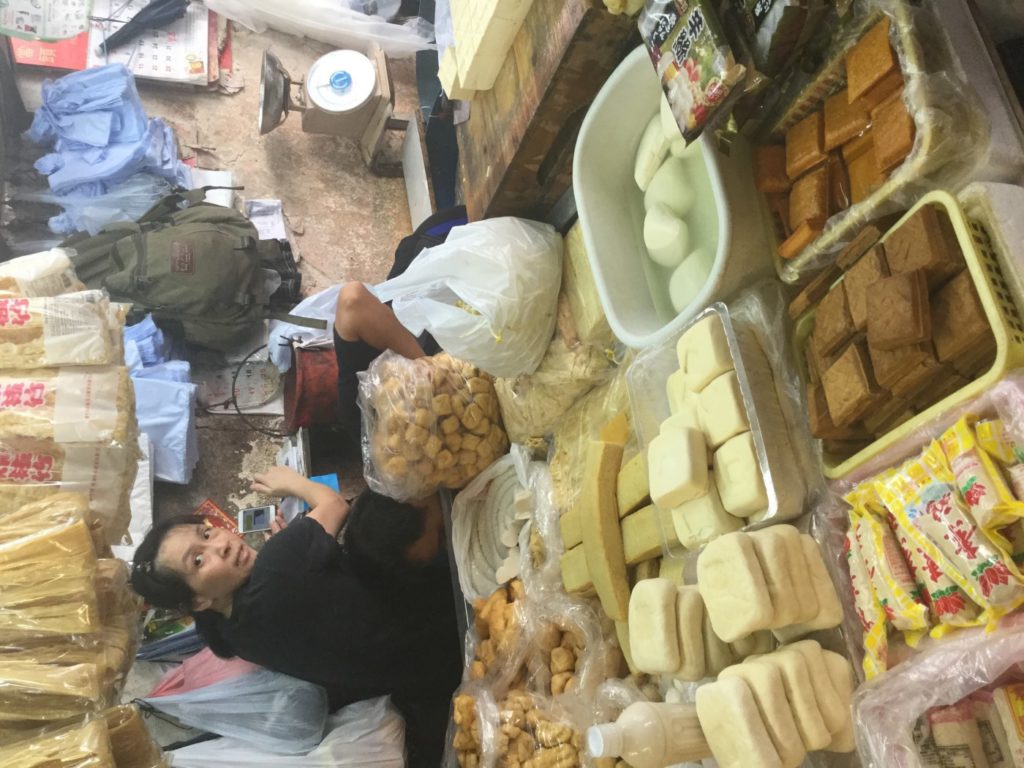
Who knew that there were SO many different varieties and shapes of tofu?
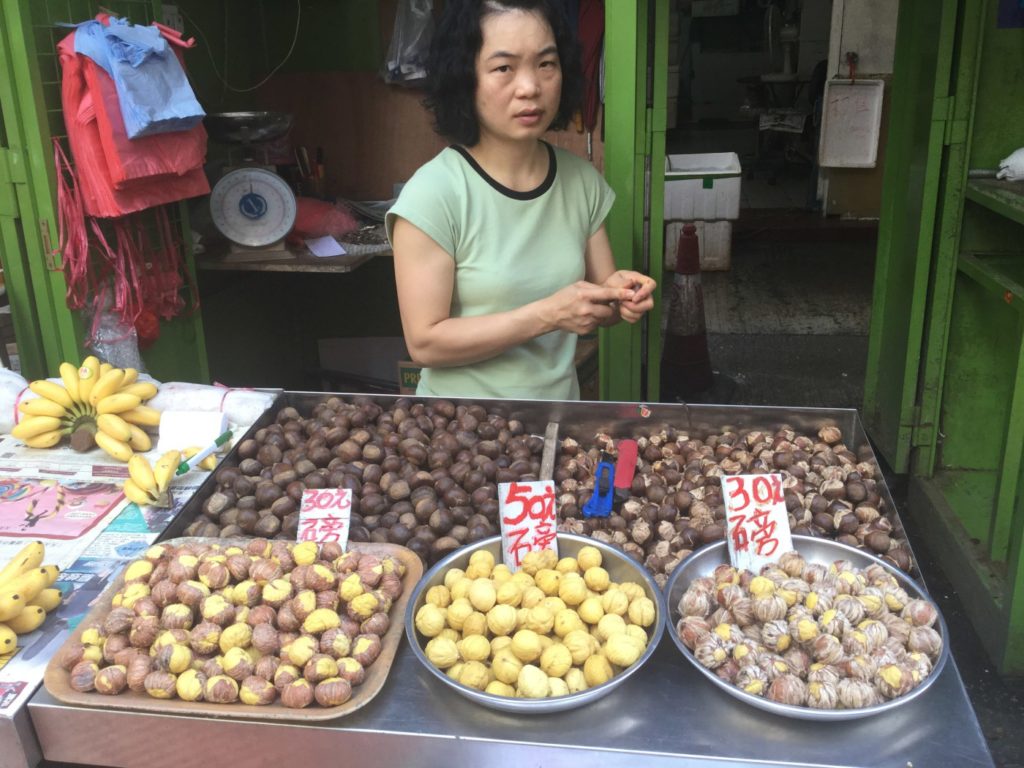
Here a vendor sells four different types of chestnuts!
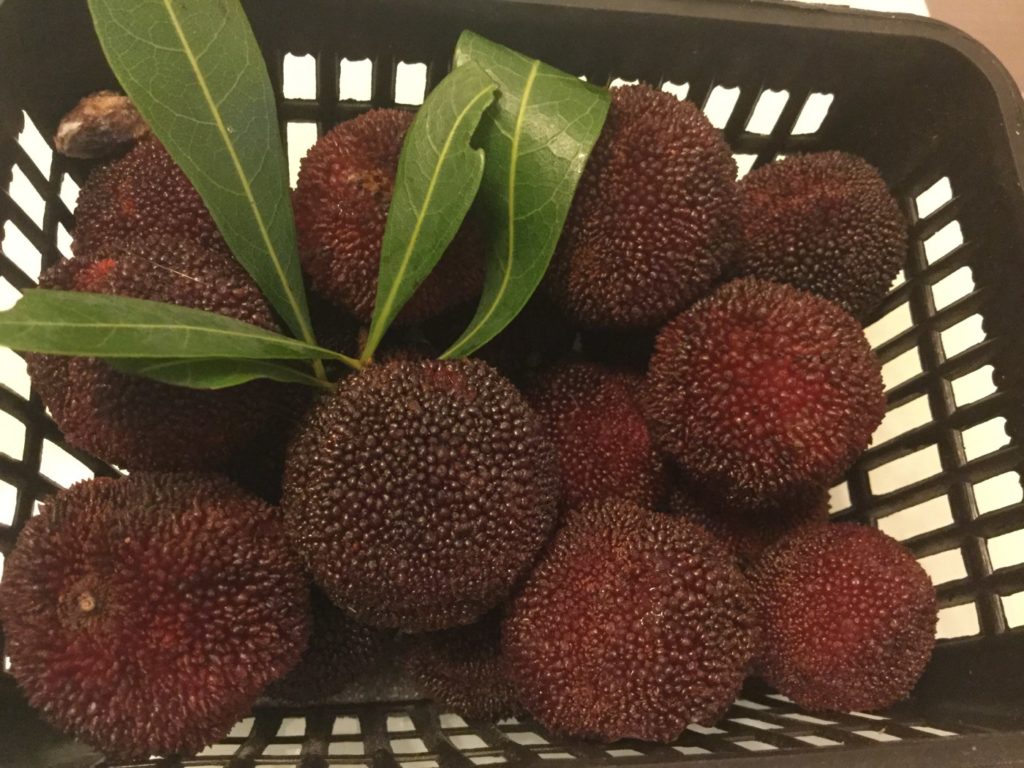
At this market we discover a delicious new fruit, the yumberry or Chinese strawberry, which has a tart taste with sweet undertones, it tastes like a pomegranate and a raspberry married together. The skin is edible too.
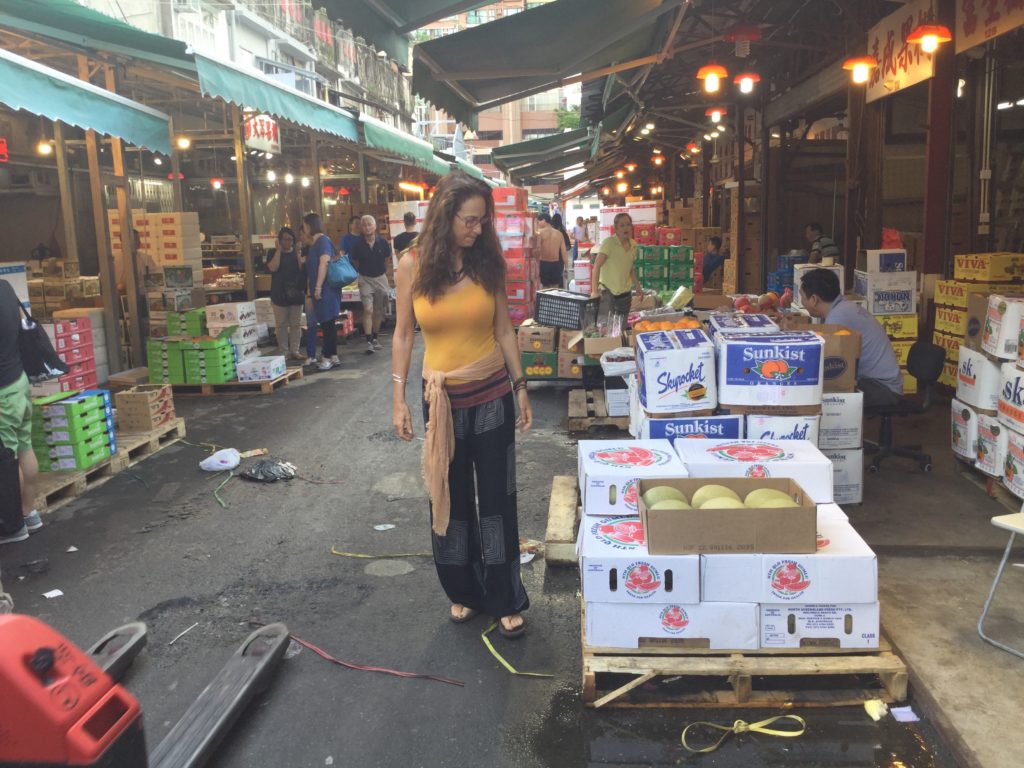 We also came across a wholesale market which sells to fruit retailers. The volume and quantity of produce was astounding, however, the fruit was only sold in 20 pound boxes. Tempting, but that is a LOT of cherries to eat over a few days. We should have!
We also came across a wholesale market which sells to fruit retailers. The volume and quantity of produce was astounding, however, the fruit was only sold in 20 pound boxes. Tempting, but that is a LOT of cherries to eat over a few days. We should have!
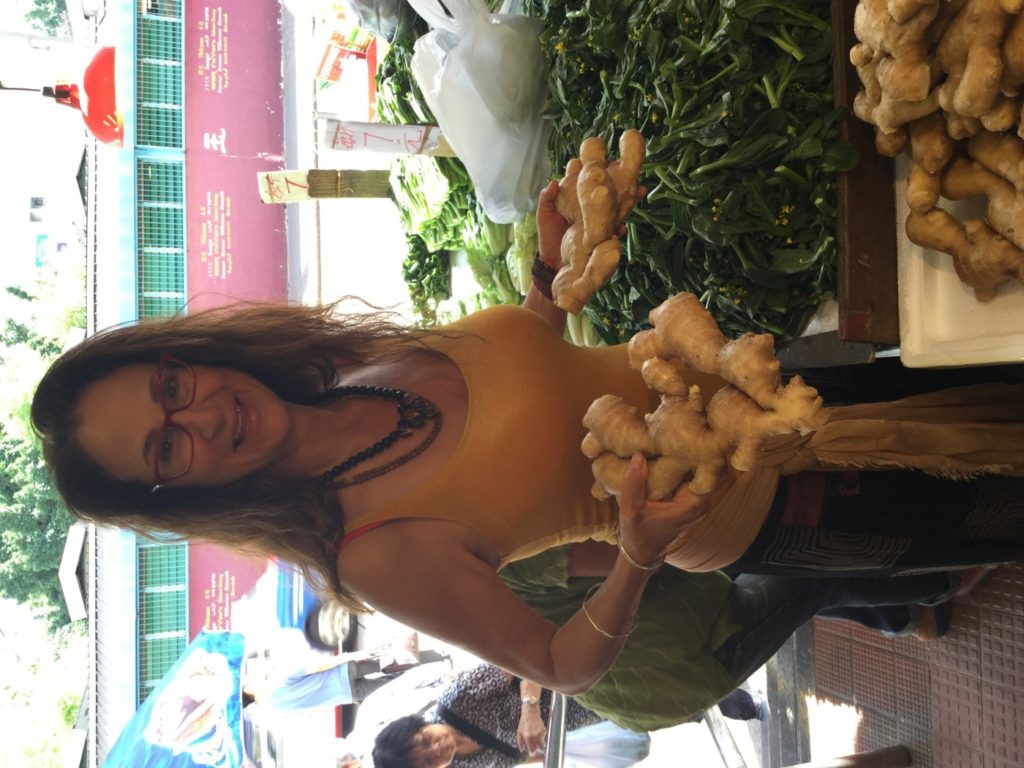
What a find! Magnificent ginger! Ginger is something Peta likea to buy fresh and have in her backpack when we travel, as it is useful for digestion issues and relieving pain.
Are any of these fruits and vegetables new to you? Have you ever tried the yumberry or snake fruit before?
Love seeing markets everywhere. Thanks for starting this series.
Thanks Peggy, there is still Part 4 to come. The last in the series. So pleased that you have enjoyed our retrospective jaunt through Asian markets.
Peta
Enjoying all of these, Hong Kong is the only one I know. Interesting to see the bags of ready prepared vegetables! I thought that was just the preserve of lazy Westerners in supermarkets. I won’t feel guilty now if I buy them…..
Haha Anabel, no possible guilt involved when buying fresh vegetables in any form…What was fun with the precut vegetables in Yogyakarta is that the woman were peeling and cutting them right then and there, so they are still really fresh. Fun to watch too.
Glad you are enjoying our market retrospective, there is one more coming up in the series!
Peta
Fabulous pictures. Your favorite of the market Jogja and the woman selling eggs is my favorite too. Love the composition, the colors, the mood.
Judith, thanks for the compliment on the photographs. We took the time to check out the different types and colors of eggs. I think that in addition to chicken and quail eggs there were goose eggs as well. Who knows what else? It is amazing how delicious eggs from rural chickens usually are, in comparison with those that are industrially farmed.
Peta
What fabulous market pictures!
I am usually a little shy (maybe a lot) about taking pictures of the vendors and shoppers. Do you have any tips or suggestions about how to take these types of pictures without offending… or making anyone angry?
Thank you Janis for the lovely compliment on the photography.
The main tip I can give for taking photographs of people, without upsetting them in any way, is to first “blend in”. When we go to a market and I know there will be a lot to photograph, I deliberately stand back or sit somewhere quietly for a while, so that I do not stand out as an obnoxious foreigner with a camera. I often engage and talk with the very people I want to take photos of. Depending on the vibe I get, I might ask them if they are okay with my taking a photo of them. Otherwise I just hang around until I am less visible, and that makes it much easier to capture a good shot. I use an ipad so that it is less threatening to people and I show them the photograph that I took of them, as this often brings a lot of smiles.
Peta
Thank you for your reply! I think that hanging back for a while is a good idea. Also, not using a DSLR, although it’s my best camera.
Most welcome Janis. I also used to sketch in markets… I would find a good corner to sit and focus, but the problem was that sketching drew way too much attention to myself, although it was also fun and yet another way to interact with locals.
Peta
I love markets, and you certainly focus in on the interesting people and their produce. Beautiful photos that capture the atmosphere.
Thanks Zwi, that is compliment indeed coming from you! Thanks for taking a stroll with us.
xoxo
P
Incredible photos and as always down to earth and very interesting postings. Thank you so much!
What a lovely compliment. Thank you Anton. Nice to know you are following our blog. Enjoy the rest of your travels in Viet Nam. Do hope you made it to Hoi An!
Peta
The last photo is a wonderful shot of you, Peta. I love it 🙂
The snake skin fruit is a new one to me. I’ve never heard of it or seen it. Now I’ll be looking for it when I’m poking around Asian markets. Maybe I’ll get lucky and find one here 🙂
Thanks Joanne, sweet of you to say…
It is so much fun once you find a new “exotic” fruit and know what it is and how it tastes, and then it is much easier to find it the next time. I think we have only eaten this in Indonesia…. but not 100% sure on that. Definitely not as prevalent as say rambutan for example.
Peta
So much eye candy it’s like a sea of color. A beautiful assault on the senses, I don’t know how you do it but your photos seem to capture the essence of the environment.
Stephanae thank you! It is good to know that we achieved our objective with our photographs! That is a really great compliment.
Glad we could deliver the visuals of these colorful Asian markets to you…
Peta & Ben
This has been a fun series to experience through your camera lens. That part of the world is not yet on our radar, which makes it all the more interesting to read your posts.
As for trying on the head scarf… when we were in Iran I wore a very thin and long head scarf that I could loosely cover my head and toss it over my shoulders to cover my neck and shoulders. The problem was, I have short hair and could not keep that damn scarf on my head to save my life. And, it’s not as if I could just take it off in public to rewrap so I was constantly fidgeting with it. It became somewhat comical but I also loathed that scarf after 3 weeks as it represented so much. I have such respect for women who are made to wear the hajib for whatever reason – they’re are many reasons – and empathy for those who wish they didn’t have to. It’s a Pandora’s Box!
I too agree with the choice of the teal dress, looks very nice.
Patti we are glad to open up a window into our part of the world. We must say though, we are jealous as we both would love to go to Iran which is high on our list of places to get to. All the Muslim women that I (Peta) have spoken with, in Sri Lanka and Indonesia have consistently told me that they wear a head covering or even face covering, out of choice. Of course, this may be different in other countries, such as Iran and Saudi Arabia.
Funny story about the fidgeting with the head scarf, haha.
Ben & Peta
The variety and colour of these food markets are astounding! You need a guide to show you around and explain about the different spices, fruit, vegetables, meats, fish etc the choices are just mind blowing. I have never heard of the “snake skin” fruit…it looks very exotic, sounds like it tasted lovely? Very good choice of a dress for you Peta, it looks beautiful.
Thanks Gilda for your feedback. We have never had a guide, because we prefer to explore on our own. Not fans of the 3rd party presence, type of thing. We also have an unusually slow pace at markets and like to take our sweet time, which might not go down so well with a guide. Of course knowing what some of the exotic stuff is and some background, is always helpful.. but we take more of a trial and error approach haha.
The snake skin fruit is delicious!
Thanks for the compliment on the dress. I actually still have it and wear it every so often and it transports me right back to that moment with those women in the market in Yogyakarta amidst all the hijabs.
Ben & Peta
You are on a roll! I’m loving this series on markets. I can really relate to this one as I’ve been to Yogyakarta and Ubud a number of times. I remember the lovely produce, but even more, the smiles and warmth of the people. You have really captured this beautifully.
Thanks Caroline, those are really nice compliments. Especially from someone who has been to both Yogyakarta and Ubud. Totally agree on the warmth of the people in Indonesia. Stand by for the fourth, and last installment in this series… India!
Peta & Ben
Wow, this post makes me miss Asia so much! And that ginger is incredible! Great post, Peta and Ben!
Thanks Kelly!! It makes us miss all those places too.. we got pretty nostalgic while we were doing a down select on our photos (not an easy task) for these posts. One more upcoming to end the series with a bang!
Peta
I am so enjoying these posts about the markets in Asia – wish we had similar in the US, but even farmer’s markets are becoming fewer as their locations become newer commercial ventures. The foods and flowers and wares look so gorgeous – such pride the vendors have in their wares and the presentation. So many tempting foods I’ve never heard of. Best of all, I love the people you photographed. Their faces and the way they sit behind their baskets – absolutely fascinating. Wondering why there are so few pics of kids – are they all in school?
Shari thanks for your enthusiastic response to our markets of Asia series. You make a good point about the pride that the vendors have in their wares and presentation. It really shows, doesn’t it.
As I think back to many of the markets we featured here, there were not many kids in the market place, so perhaps as you suggest, they were in school during market times. Seems like the market is adult focused… save for the occasional really young one with its mom.
Ben
Oh local markets, especially in Asian countries, are so much more alive. That’s also true compared to the ones in the United States, in my opinion. You know you’re not just buying, but also helping the hardworking local vendors. And you can really feel the connection. There’s so much more than going to a well-organized, pretentious supermarkets. This is just going to a market and it feels and looks like a full-on travel experience. Well put together post! Love seeing the smiles, in particular.
Rommel thanks for pointing out the human dimension of “helping the hardworking local vendors”. It is so much more satisfying buying directly from farmers and vendors than from a supermarket. We strive to have social impact and have done this consistently through a number of programs we have put together over the last few years, but it is true that the easiest and simplest form of help is to buy a quality product directly from a small scale vendor. Thanks for dropping by our blog and for your interesting comments.
Ben
I’ve enjoyed these three posts in the series very much. Such a cornucopia of the senses. The photos brings back memories of Thailand decades ago. I can still remember the smell of the unidentified marine detritus for sale in the markets. Good to see the tradition of markets is still going strong over there.
JD glad you have enjoyed the three posts, stay tuned for one more coming up soon, on India. As the average income goes up and discretionary income is available to buy refrigerators, it is almost inevitable that at least in urban centers, there will be an increasing reliance on “modern” large supermarkets. Thankfully, the cultural bias in favor of super fresh food, remains strong.
Ben
Most of these are new to me… What amazing variety! When it comes to Asia, I’ve only ever been to Taiwan.. but I think Asian culture is so foreign to most Westerners that the continent has this almost infinite ability to constantly surprise.
Dee that is an interesting observation. We have now lived in different parts of Asia for 3 years ( and Ben lived in Japan for 5 years, before), yet as you say, it continually provides a stream of surprises, even though it is definitely not “foreign”, which is one of the reasons we love it!
Thanks for reading Green Global Trek and leaving your feedback…:)
Peta
Wonderful shots of the markets everywhere! What a treat to see your perspective of Ubud’s market; I too have taken loads of birds eye view shots; they capture the full range of colors and some of the movement. Hope you’ll come again and we can traipse through the market (and other parts) too. I’m hoping to make it to Jogja one of these days.. I can’t believe I haven’t been there yet!! Sampai jumpa lagi
Thanks Amit, we will no doubt return to Ubud hopefully sooner rather than later. Glad you enjoyed our perspective of your home town market place. Going to Jogja after Ubud was a bit of a shock to the system. We were there right after the volcano eruption and the city was covered in a film of volcanic ash giving everything a somewhat grey hue. But after a few days of adjusting, Yogyakarta definitely starts to grow on you.
Peta & Ben
Please send me a jaggery, a yumberry, a coconut cylinder, and a purple sari. Also a cigar, but I’m just gonna look at it as I don’t smoke. Love the photo of Peta and the ginger roots – that would last me five years. And the painted rickshaws. Boy, does this make my local grocery store look boring. Thank you for this wonderful tour – you are better than any of the TV travel shows. And now I’m hungry, of course.
Hahaha Shari that’s too funny. If you send me your email address we will send you some jaggery!! Won’t that be something fun to get in the mail?
Ginger is something we started to look for whenever we go to markets, so as to have some with us for any potential stomach issues or headaches. It is really good for reducing inflammation.
Well that is a real compliment Shari! Maybe a TV travel show producer will see this and jump on your suggestion, haha. So glad you enjoyed these posts so much Shari.
Peta
My goodness a feast for the eyes! So much to see and love in this instalment in your series. The photos of the older vendors intrigue me. Would the younger member so fit family be out producing the product and the matriarchs given the the task of the markets? The reed bags and rattan baskets are marvellous. It would take me weeks to get through such a market for having to stop and investigate and chat as best I could and of course to try in clothes!
Well thank you Sue! Perhaps you are correct in your assumption of the younger members of family being out in the fields, although my guess is that the trend of younger people leaving the farms to work in the big city means in many cases the older folk are doing much of the work. There is a real demographic issue in farming communities all over the world as it is very hard work for very little money and a country like Indonesia, which has a booming economy, can offer many alternatives for an educated younger generation.
Ben
You and Ben brought the market sights to life with your fabulous photos and narrative. I felt like I was right there with you and would love to experience the sounds and smells as well. I’m sure it must all be a feast for the senses!
The rickshaws of Yogyakarta are lovely and that cigar chompin’ mama might have been one of my favorite photos, too. But, oh, the flowers of Ubud! I think this post more than any others I’ve read finally brought home to me why Ubud is such a favorite destination!
Thanks Anita. We do also have some video footage of most places we visit and of course those capture the sound and the energy level, but there is no invention for capturing smells (yet). We have found that when we post videos as part of a blog, people tend to not watch them, probably due to time constraints, but maybe one day we will start doing video retrospectives.
Ubud has become very popular in the last few years. So much so that in just two years from our first visit to second visit, we noticed a significant uptake in the traffic and in general the place is spreading with more rice fields being converted for construction of villas and hotels. Still it retains an authenticity if one takes the time to get out of the main central streets.
Peta & Ben
This is awsome! I love the places you show us, and the really nice pictures here. I have just added another few places to the list of places I’d like to visit in Asia.
Glad you enjoyed this post on markets Martine. Thanks for stopping by Green Global Trek and commenting.
Peta